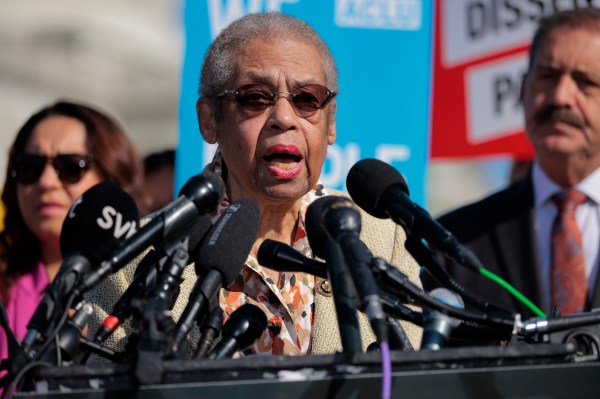By the end of the month the Supreme Court will hand down a decision in an immigration dispute between the Biden administration and individual states that could boil down to the meaning of the word “shall.”
In United States v. Texas, at question is whether the executive branch can issue narrow guidelines for detaining or deporting immigrants in the country illegally, whether states can challenge the executive branch on immigration enforcement, and whether the courts can universally nullify federal agency action.
The controversy dates back to a September 2021 memorandum issued by Department of Homeland Security Secretary Alejandro Mayorkas stating that federal immigration authorities should prioritize for detainment or deportation three categories of illegal immigrants: suspected terrorists, those otherwise a threat to public safety, and recent illegal border crossers.
Some Republican-led states strongly objected to those guidelines and sued. A U.S. district judge in Texas agreed with Texas and Louisiana (who sued over the memo) and vacated the policy last June, preventing the Biden administration from implementing the memo. The Supreme Court rejected an appeal to let the administration move ahead with the policy while the government appealed, but the justices agreed to take up the case even before the court of appeals weighed in. Since then, several other states have filed amicus briefs.
Is this a familiar issue?
In laying out specific immigration enforcement policies, the Biden administration is following in its (Democratic) predecessor’s footsteps. During the Obama administration in 2011, then-Director of Immigration and Customs Enforcement (ICE) John Morton laid out in several memos a plan for whom ICE would prioritize in its enforcement of the nation’s immigration laws. The focus should be on “violent criminals, felons, and repeat offenders,” those involved with organized criminal gangs, or who were otherwise a public safety risk, among others, he said. He also specified who was a low priority for deportation, including those who were sick, elderly, disabled, or whose detention would not be in the public interest. But the memo didn’t prevent ICE exercising discretion: The Obama administration holds the record for the most deportations in modern history, with more than 3 million over his eight-year presidency.
Former President Donald Trump saw things differently. Soon after he took office, Trump issued an executive order expanding deportation prioritization to those “subject to a final order of removal, but who have not complied with their legal obligation to depart the United States.” Yet even under Trump, the number of deportations each year never reached the highest numbers of Obama’s earlier years.
Does ‘shall’ mean ‘shall’?
The Biden administration policy was a repudiation of Trump’s approach, with Mayorkas making a practicality argument justifying the guidelines: The government doesn’t have the manpower to apprehend and remove the estimated 11 million people in the country illegally.
But that argument doesn’t negate the government’s obligation to enforce immigration laws on the books, lawyers for the states have argued.
The states argue the administration is failing to follow two provisions in the Immigration and Nationality Act (INA). The laws say that the government “shall take into custody any alien” who has committed certain crimes or is deemed inadmissible or deportable. And that the government “shall remove” anyone with a final deportation order within 90 days.
The guidelines, Texas Solicitor General Judd Stone Stone said in oral arguments in November, give federal immigration officials the ability to view “their mandatory obligations as discretionary” and have the effect of “reducing the number of detentions.” The states’ position is that the word “shall” does not leave room for prosecutorial discretion as the Biden administration has argued.
Chief Justice John Roberts asked about the Biden administration’s feasibility concerns, calling the argument compelling: “It is impossible for the executive to do what you want him to do, right?”
“Assuming we think it would be, if not impossible, surprising and very difficult for the executive to comply, isn’t that a consideration we should take into account in trying to figure out if ‘shall’ means ‘shall’?” he added. “There are cases where we’ve said ‘shall’ means may.”
This was not one of those statutes, Stone responded. The government’s argument was in bad faith because the Biden administration has “repeatedly sought to decrease their enforcement capabilities, to decrease their detention capabilities” and underutilize both, he added.
The states also argued that the policy is invalid because the Department of Homeland Security guidelines did not follow the federal rulemaking process, which includes a notice and comment period. That’s a familiar argument in immigration issues—both the Obama administration’s creation of Deferred Action for Childhood Arrivals (DACA) and the Trump administration’s attempt to rescind DACA circumvented the notice and comment period.
The Biden administration disputes the states’ interpretation of the INA and contends that “shall” in this case means “may.” The law “does not create an unyielding mandate to apprehend and remove every non-citizen described in provisions that use the term ‘shall,’” U.S. Solicitor General Elizabeth Prelogar said.
“Across 25 years and five presidential administrations, the agency has never implemented the INA in a manner that the respondents suggest,” Prelogar said. She also blamed the agency’s manpower problems on “congressional funding choices.”
Siding with the states would “deprive the secretary of his statutory authority to set priorities to protect the nation’s security and borders,” Prelogar said.
What rights do states and courts have?
Other questions raised by the case—whether the states have standing to challenge policy and whether a lower court’s action to vacate the policy was correct—also need answers.
Both the Obama and Trump administrations frequently faced challenges to policy changes from state attorneys general of the opposite party, and that’s continued apace for the Biden administration.
The states incurred law enforcement costs, social services costs, and “very serious threats of recidivism that must be considered,” Stone argued. He reminded the justices that the Supreme Court has recognized in the past that “the states bear many of the consequences of federal immigration decisions.”
“We’re creating a system where a combination of states and courts can bring immigration policy to a dead halt,” Justice Elena Kagan said, concerned that the bar to prove legal standing is too low.
But Prelogar faced tough questions while arguing that the states lacked standing, with Justice Samuel Alito characterizing the Biden administration’s position as having “special hostility” toward states on the question.
Roberts, Justice Brett Kavanaugh, and Justice Ketanji Brown Jackson also seemed skeptical of Prelogar’s other argument that the courts lack the power to vacate agency action. All previously served on the U.S. Court of Appeals for the District of Columbia Circuit, where Roberts said judges vacated executive action “five times before breakfast.” Kavanaugh called the position a “pretty radical rewrite” of standard administrative law.
Will a decision address all the legal questions at stake?
Even with so much riding on their decision, the justices may not answer all three legal questions before them, John Harrison, a professor at the University of Virginia School of Law, tells The Dispatch. One route the justices might take is to issue a more narrow ruling holding that Texas and Louisiana lack standing: “The Court might take a more restrictive view of the circumstances under which the States can sue federal agencies seeking relief against agency programs” without addressing other questions.
But a broader ruling in the case could allow the justices to clarify judicial review of federal administrative agencies and the “permissibility of universal relief”—the notion that a court’s ruling against federal policy applies to everyone, not just the parties in the case.
“The basic conflict over the last few years on immigration policy has been the administration's assertion of what it calls enforcement discretion, but in a sweeping way that looks almost like the writing of laws,” Adam White, a senior fellow at the American Enterprise Institute, tells The Dispatch.
He is “curious to see if this case becomes an occasion for the court to put at least some limits on state standing.”
“If I had to bet on this case, the states have standing,” White says. “The court holds that the administration’s policy unlawfully avoided the notice and comment process and they nullify the memorandum’s effectiveness based on that.”
But even if the Biden administration loses, White doesn’t expect a drastic change in on-the-ground immigration enforcement: “Immigration officials at the enforcement level, they’re still going to have to decide how to marshal their scarce resources.”






Please note that we at The Dispatch hold ourselves, our work, and our commenters to a higher standard than other places on the internet. We welcome comments that foster genuine debate or discussion—including comments critical of us or our work—but responses that include ad hominem attacks on fellow Dispatch members or are intended to stoke fear and anger may be moderated.
With your membership, you only have the ability to comment on The Morning Dispatch articles. Consider upgrading to join the conversation everywhere.